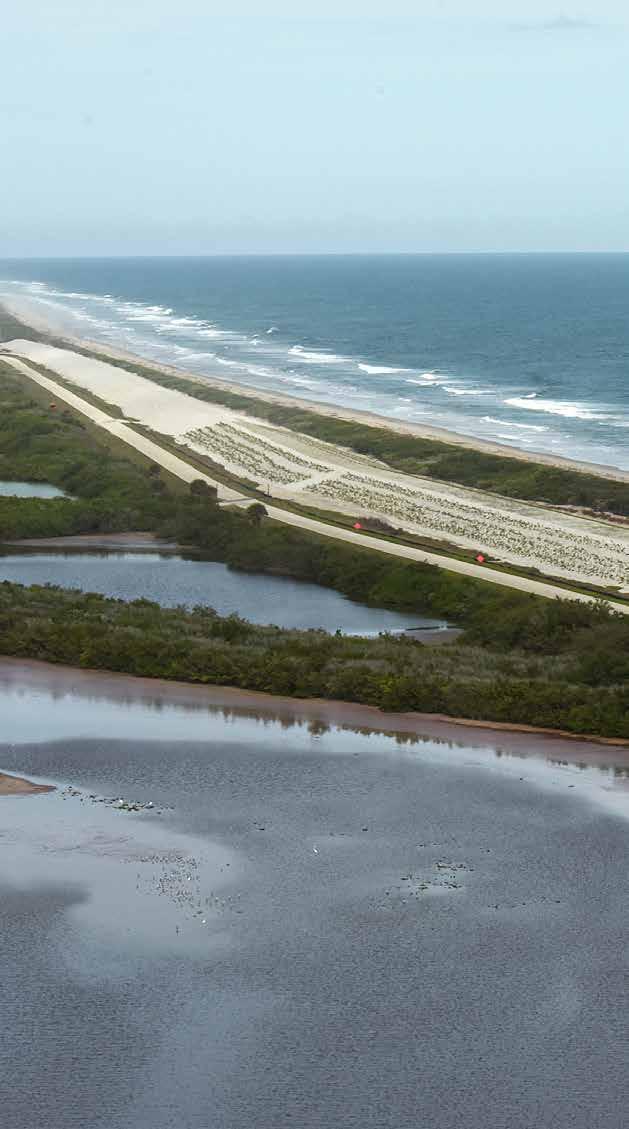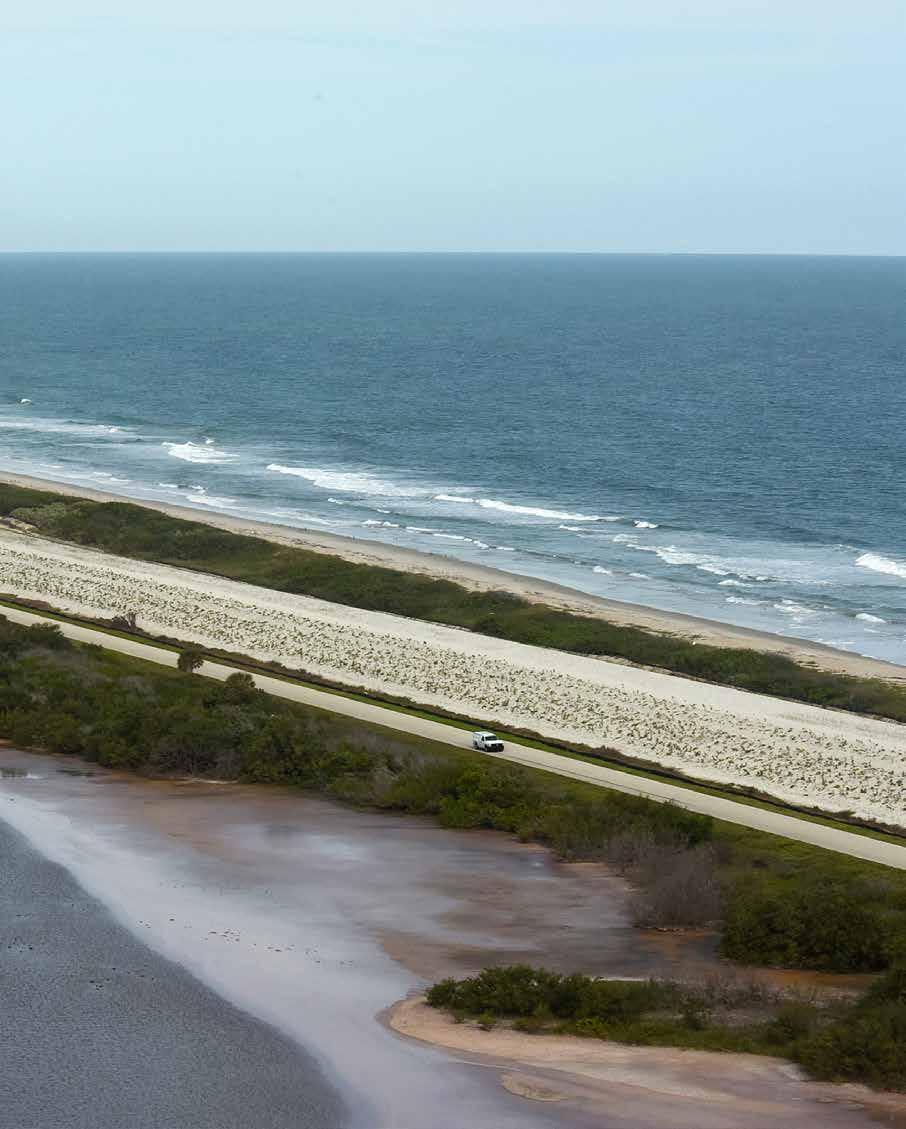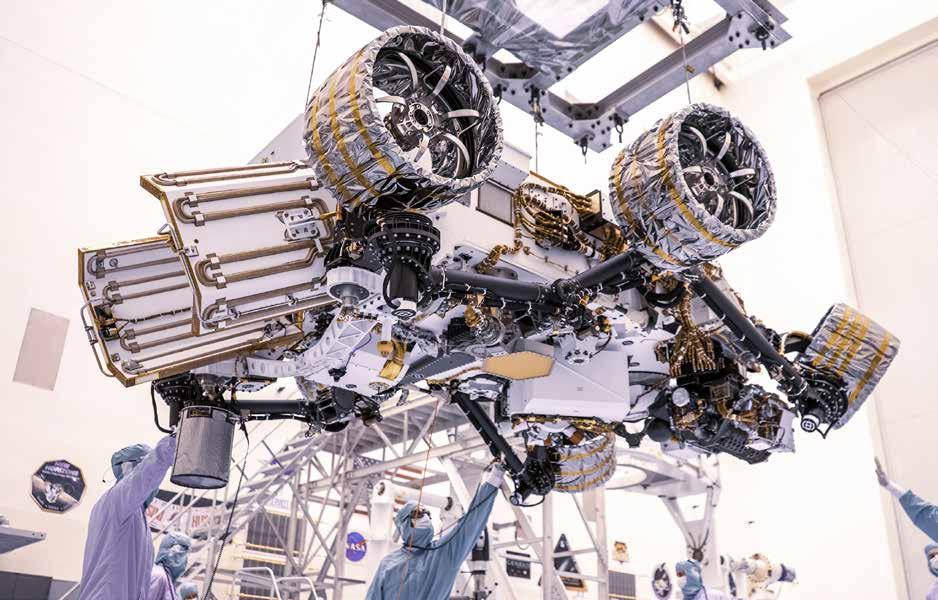
8 minute read
Safety and Mission Assurance
Exploration Ground Systems and SI completed a Multi-Element Verification and Validation test series on the Launch Complex 39B Ignition Overpressure Protection and Sound Suppression (IOP/SS) system. The IOP/ SS is a gravity-induced, high-volume water deluge system that will protect the Space Launch System rocket from high energy generated during launch by the solid rocket boosters and core stage main engines.
The system’s final test, conducted Oct. 12, 2019, included the activation of the igniters that burn off any free hydrogen that potentially collects at the aft of the rocket just before liftoff. IOP/ SS also successfully passed the Design Certification Review milestone in spring 2020.
Advertisement


LANDMARK HONOR
The American Society of Civil Engineers (ASCE) recognized the iconic VAB as a National Historic Civil Engineering Landmark during a dedication ceremony organized by SI. The directorate worked with Kennedy’s Communications and Public Engagement Directorate and the ASCE. The event featured multiple speakers, including Florida Department of Transportation Secretary Tribault and Center Director Bob Cabana. The dedication plaque is mounted on the VAB wall by the entrance, where it will inform all who enter of the building’s important legacy to the nation.
MATERIAL MANAGEMENT
All contractors managing Kennedy’s installation-accountable government property were added to the Supply Management System in February 2020. The system identifies and accounts for NASA-owned supplies and materials, providing the data necessary to properly account for and identify items in inventory. An ongoing effort is underway to locate, record, and track items currently stored in various locations around the spaceport, resulting in better accountability of supplies and materials.
Kennedy’s Property Management Office Team implemented a new agency inventory requirement for the spaceport’s Administratively Controlled Equipment (ACE). ACE is subject to annual inventory by random sampling to ensure property accountability and prevent fraud, waste, and misuse.
$3.1 Million
added to the center’s budget via reutilization of excess property
$162,000
Efforts to restore Kennedy’s Atlantic shoreline are nearing completion. The project protects valuable inland launch and support infrastructure, as well as critical wildlife habitat from storm surge events and inundation.


BIOMEDICAL ENGINEERING AND RESEARCH LABORATORY
The Biomedical Engineering and Research Laboratory (BERL) continues its efforts to improve the state-ofthe-art of liquid air-based life-support technology. EGS has funded the development of several technologies to improve the safety and sustainability of the current fleet of environmental control unit packs.
✧ Refining and manufacturing a 3D-printed Venturi tube to replace the existing tubes, reducing pack weight and costs while improving sustainability
✧ Improving the current design of the Attitude
Independent Pickup (AIP), which allows the pack to operate in all physical orientations within 90 degrees of upright
✧ Designing a new liquid air dewar for the packs to replace the existing ones that are no longer commercially available; the new design will accommodate the new AIP and improve the sustainability of the existing pack by providing replacement parts
✧ Developing a liquid level sensor that would allow a direct measurement of the amount of remaining air, rather than the existing indirect, time-based method of operation
PROTECTION FOR THE FUTURE
Kennedy’s Protective Services purchased several new vehicles to ensure the spaceport is operationally prepared for the future. • Bearcat armored personnel carrier • Sutphen Ladder Truck • Mobile Command Vehicle • Sutphen Quint Fire Engine
Safety and Mission Assurance
The Safety and Mission Assurance Directorate is an independent branch of NASA that identifies and mitigates risks to mission success and ensures the safety of astronauts, the spaceport’s unique workforce and property, and the public during all Kennedy Space Center activities. The directorate’s mission is to enable safe and successful access to space by focusing on three core values: helpfulness, relationships, and knowing what matters.
World-Class Safety and Health Culture
Safety and Mission Assurance cultivates and maintains Kennedy Space Center’s strong safety culture across our missions, research, and day-to-day activities. Despite challenges introduced by the coronavirus, the safety culture instilled in our community remains strong, allowing us to continue pushing boundaries and completing our missions.
Program/Project Support
Safety and Mission Assurance supports all programs and projects across the multi-user spaceport. The Safety and Mission Assurance Commercial Crew team collaborated with Commercial Crew Program Engineering, the Spacecraft System Office, and NASA’s commercial partners to support the development and operation of a new generation of spacecraft and launch systems capable of carrying crews to low-Earth orbit and the International Space Station. This team performed surveillance activities for SpaceX’s Demo-2 and Boeing’s Orbital Flight Test, including documentation reviews, observing procedures, and reviewing test results, and performed audits to ensure compliance with safety requirements, while identifying and mitigating hazards. The team also reviewed expected and emergency operation plans at the launch site to ensure the safe ingress and egress of astronauts and ground crews. The directorate’s Launch Services team contributed to the processing and launch of the Ionospheric Connection Explorer (ICON), Solar Orbiter, and Mars 2020 missions by providing independent assessment of risks to mission success and verifying launch vehicle systems and the integrated vehicles met NASA requirements. The team also protected Kennedy personnel and facilities by providing quality insight and independent assessments into the launch vehicle providers, ensuring the payload and launch vehicle were processed safely. The Safety and Mission Assurance Exploration Ground Systems (EGS) team provided onsite quality assurance by ensuring vendors met contract requirements while fabricating the Exploration Upper Stage Umbilical, the vehicle support posts for the new Mobile Launcher 2, and the crew access arm hinge access platforms for Mobile Launcher 1, to name a few.

Engineers perform mass properties testing on NASA’s Mars Perseverance rover inside Kennedy Space Center’s Payload Hazardous Servicing Facility on April 7, 2020.
EGS verification and validation testing identified and mitigated hazards and will continue to do so as Artemis I flight hardware processing begins. The EGS team also developed the Orion Quality Assurance Surveillance Plan to document NASA Quality’s insight into Orion activities prior to turnover of flight hardware from Lockheed Martin, and oversaw the completion of major Orion Crew Module assembly operations and integration with the European Service Module for Artemis I. The directorate’s Exploration Research and Technology (ER&T) team performed safety reviews to ensure safe and successful ground processing of more than 30 International Space Station payloads, including Bartolomeo, CLARREO Pathfinder, and Astro Gardener. The ER&T team prepared safety analyses for multiple research and technology projects, conducted lab safety walkdowns and safety insight of payload processing operations, and provided quality assurance for On-orbit Servicing, Assembly, and Manufacturing (OSAM), MSolo, rodent research, power/data testing for station utilization payloads, and space station Orbital Replacement Unit processing. The team also contributed to formulation and planning for Gateway’s Deep Space Logistics project and supported planning for Human Landing System Program ground and lunar surface operations. The Institutional team continued to make significant progress toward flight safety analysis for advancing the Range Safety capability.The team formed a cross-agency collaboration with the 45th Space Wing and the Federal Aviation Authority to standardize analysis products, and built a training plan to develop risk analysis capabilities for current and future range safety officers. Range and flight safety engineers provided the capability for assessment, creation, and implementation of risk analyses for flight safety operations. As the multi-user spaceport grows, including more commercial launch partners and continuing NASA operations, the Institutional team also ensured construction safety by performing safety surveillances for over 150 construction projects across the center in fiscal year 2020. The continued hard work and dedication of the Safety and Mission Assurance team has been vital to maintaining the versatile spaceport the center is today.
Safety and Health Week
Each year, Kennedy Space Center observes Safety and Health Days to show our commitment to the well-being of our workforce. This year’s theme was “Know What Matters,” which applied to life at home and at work. During the week, more than 2,500 employees attended nine special presentations featuring favorites such as astronaut Dr. Stan Love, former astronaut Jim Wetherbee, and integrative nutrition health coach and chef Carly Paige. A United Launch Alliance Atlas V rocket carrying Boeing’s CST-100 Starliner spacecraft rolls out of the Vertical Integration Facility to the launch pad at Cape Canaveral Air Force Station’s Space Launch Complex 41 on Dec. 18, 2019, ahead of the Orbital Flight Test.

Leading the Charge on Risk-Based Decision Making

Risk is an inherent part of NASA’s mission, and maintaining a balance between risk and benefit while keeping safety in the forefront is the responsibility of every Safety and Mission Assurance team member. Safety and Mission Assurance uses risk-informed decision making as part of the directorate’s “Yes, if” strategy, allowing teams to embrace flexibility through alternative solutions while maintaining safety and actively managing the risks associated with them. Building on Safety and Mission Assurance’s desire to maintain a strong safety culture and encourage continuous improvement, the directorate created a video series explaining and demonstrating its risk approach. Above: A SpaceX Falcon 9 rocket with the company's Crew Dragon spacecraft onboard is seen as it is raised into a vertical position at Kennedy Space Center’s Launch Complex 39A on May 21, 2020, as preparations continued for NASA’s SpaceX Demo-2 mission.


Above: The Orion spacecraft is moved to the Final Assembly and Systems Test cell at Kennedy Space Center on March 30, 2020. Photo credit: Lockheed Martin
Above: In High Bay 4 of the Vehicle Assembly Building at NASA’s Kennedy Space Center in Florida, pathfinders, or full-scale replicas of Space Launch System solid rocket booster segments, are stacked during a training exercise on Jan. 8, 2020.
Right: Airbus workers inspect the Bartolomeo platform after it was unpacked from its shipping container in Kennedy Space Center’s Space Station Processing Facility high bay on Jan. 30, 2020. Manufactured by Airbus Defence and Space, Bartolomeo was delivered to the International Space Station aboard SpaceX’s 20th Commercial Resupply Services (CRS20) mission for the agency.









